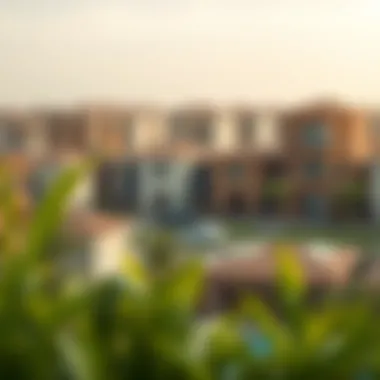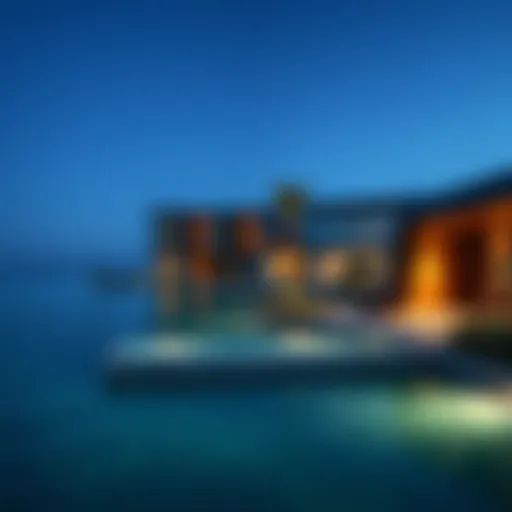Understanding the Role of Tiger Developers in Dubai's Real Estate


Intro
The urban landscape of Dubai is continually evolving, thanks in large part to the tireless efforts of tiger developers. These are not just any builders; they represent a unique category of real estate developers, distinguished by their aggressive approach to growth and development. In a city famous for its skyscrapers and luxurious living, the influence of these developers cannot be overstated.
Their projects often redefine city planning and set trends that ripple across the global market. As such, understanding the role of tiger developers becomes paramount, especially for investors looking to navigate the complexities of Dubai's dynamic real estate sector.
With rapid urbanization leading the charge in transformation, this article explores how these developers contribute to the shifting sands of Dubai’s property market. From the lessons they impart through successful case studies to the urban planning they influence, each element plays a vital part in shaping the city’s future.
In the forthcoming sections, we will look at market insights, investment strategies, and much more to provide a detailed overview that caters to various stakeholders including investors, realtors, homebuyers, and analysts.
Defining Tiger Developers
Understanding tiger developers is pivotal in grasping Dubai's real estate landscape. These dynamic entities are not only the backbone of urban growth but also act as catalysts for economic vibrancy in the region. In a market that is often characterized by rapid changes and high stakes, recognizing what sets tiger developers apart—both in their operational strategies and their impact—is essential for anyone involved in real estate, whether they are investors, homebuyers, or market analysts.
Characteristics of Tiger Developers
Tiger developers exhibit certain defining characteristics that allow them to thrive in such a competitive environment. Their hallmark is an aggressive approach to project development and investment. Some key traits include:
- Innovation and Modern Design: A focus on contemporary architecture that often becomes iconic within the city’s skyline. Developers have ventured into using advanced materials and innovative construction techniques, ensuring both durability and aesthetic appeal.
- Market Responsiveness: These developers are adept at analyzing market conditions and adapting their strategies accordingly. They stay ahead of trends, ensuring they create not just buildings, but thriving communities that meet evolving needs.
- Aggressive Financing: They leverage a variety of funding models, including private equity, debt financing, and strategic partnerships. This resourceful financial approach allows them to undertake ambitious projects that may not be feasible for others.
- Sustainability and Environmental Awareness: Many tiger developers are increasingly prioritizing sustainability in their projects. This focus is not just a trend; it reflects an understanding of the long-term merits of eco-friendly buildings that appeal to modern buyers.
These characteristics enable tiger developers to not only complete projects, but to redefine the landscapes they contribute to. Such proactive development has profound repercussions on the economy and infrastructure of Dubai itself.
Historical Context and Emergence
The emergence of tiger developers can be traced back to Dubai’s meteoric rise as a global city. Originally, Dubai was known primarily for trade, but as it transitioned into a hub for tourism and finance, the demand for real estate soared. In the early 2000s, significant projects such as the Burj Khalifa and Palm Jumeirah marked a turning point. These projects were spearheaded by visionaries who would later be classified as tiger developers.
Factors contributing to their rise include:
- Government Support: The Dubai government has historically implemented policies and initiatives aimed at bolstering foreign investment and simplifying ownership laws. This supportive environment has allowed tiger developers to flourish.
- Economic Diversification: As the city's economy diversified away from oil dependency, new chances for property development emerged. Tiger developers capitalized on market needs for commercial, residential, and mixed-use structures.
- Global Events: Major events like Dubai Expo 2020 (now held in 2021 due to the pandemic) showcased the city’s potential and brought in investors and tourists alike, leading to a surge in real estate projects spearheaded by tiger developers.
The Impact of Tiger Developers on Dubai's Real Estate
In the ever-evolving landscape of Dubai's real estate, tiger developers have emerged as pivotal players, steering the market with their distinct characteristics and strategies. These developers don’t just build properties; they create entire ecosystems, contributing to urban development and reshaping the city's physicality. Their involvement is significant in numerous ways, from driving infrastructure improvements to enhancing the cityscape. Understanding the impact of these developers can equip investors, realtors, homebuyers, analysts, and renters with insights crucial for navigating the complexities of this dynamic market.
Urban Development and Infrastructure
The influence of tiger developers on urban development is nothing short of transformational. They are often at the forefront of large-scale projects, driving initiatives that extend beyond mere residential or commercial buildings. These endeavors frequently incorporate aspects of urban planning that enhance the overall infrastructure.
For instance, when considering a project like Dubai Marina, developers didn’t just throw up few towers. They planned and created an integrated community that included parks, retail spaces, and waterways, effectively enhancing the livability of the area. Key elements of their contributions include:
- Transportation: Many tiger developers invest in improving transportation links to their projects. Enhanced access points like roads, metro stations, or cycle paths may not only benefit their developments but also the wider community.
- Public Amenities: Parks, schools, and healthcare facilities often accompany new residential projects, resulting in a holistic living environment. This considerate approach promotes a higher quality of life for residents.
- Sustainability Initiatives: There’s also a growing trend towards sustainable developments, with tiger developers incorporating renewable energy, waste management systems, and eco-friendly designs into their projects.
The foresight to build not just for today but for tomorrow is a hallmark of effective tiger developers.
This extensive involvement in urban infrastructure signifies how tiger developers play a crucial role in the physical and socio-economic fabric of Dubai. It demonstrates a commitment to elevating community standards and providing long-term value for both residents and investors.
Shaping the Dubai Skyline
One cannot discuss the impact of tiger developers without acknowledging their significant role in shaping Dubai's skyline. Over the years, tiger developers have spearheaded projects that have not only drawn international attention but also become symbols of architectural innovation and modernization.


Take the Burj Khalifa as a quintessential example. Developed by Emaar Properties, this landmark not only redefined the limits of architectural design but also positioned Dubai on the global map as a city of towering ambitions. The skyline serves as a testament to the creativity and engineering prowess of these developers. Key aspects of their influence include:
- Iconic Designs: Tiger developers often collaborate with world-renowned architects, leading to groundbreaking designs that push the envelope. Such projects can uplift an entire area, changing its perception at a local and international level.
- Cultural Identity: As these buildings rise, they contribute to a sense of identity and pride among residents. Thus, they play a vital role in branding the city itself, being part of its cultural narrative.
- Tourism Boost: Major developments attract tourists, which is a boon for the economy. More visitors mean more business for local enterprises, further invigorating the economic environment.
Investment Strategies Employed by Tiger Developers
The role of tiger developers in Dubai's real estate landscape offers a fascinating glimpse into the operational mechanisms that drive one of the world’s most dynamic property markets. Their investment strategies are key to understanding how these firms navigate challenges and seize opportunities. These developers play a pivotal part in the economic pulse of the city, attracting global investors looking to capitalize on Dubai’s growth.
Tiger developers typically employ several strategies that not only mitigate risks but also maximize returns on their investments. Understanding these strategies helps to illuminate their approach and emphasizes their impact on Dubai's real estate sector.
Market Analysis and Demand Forecasting
Market analysis is a cornerstone of any successful investment strategy. For tiger developers, this analysis goes beyond simple statistics; it involves delving deep into consumer behavior, demographic trends, and market demand. Such extensive research provides a comprehensive picture of where the opportunities lie and helps to forecast future demand.
A prime example can be seen with how these developers track expatriate trends. For instance, with a considerable number of professionals moving to Dubai yearly, tiger developers study migration patterns and identify which neighborhoods are likely to surge in popularity. With this information, they can strategically launch projects that cater to anticipated demand, thus aligning their investments with the market’s evolving landscape.
Additionally, they often employ advanced data analytics tools to gain insights into market dynamics. By analyzing key indicators such as average rental prices, property sales data, and even social media sentiments, they can better understand what prospective buyers and renters are looking for. This nuanced understanding of the market helps them to create properties that not only meet current needs but also anticipate future desires.
"The secret to successful real estate investment lies in knowing the market inside and out," experts often say. For tiger developers, this understanding is second to none.
Funding Models and Financial Planning
The financial aspect of development is just as critical as market analysis. Tiger developers often adopt diverse funding models to support their ambitious projects. Instead of relying solely on traditional bank loans, they frequently explore alternative funding options such as venture capital or crowdfunding.
This hybrid approach allows developers to tap into various revenue streams while reducing dependence on single sources of finance. For example, a prominent tiger developer may initiate a luxury project funded partially by international investors via a real-estate crowdfunding platform. Not only does this democratize investment, but it also enables developers to raise capital faster than through conventional means.
Moreover, meticulous financial planning is essential. Building a robust financial model helps developers predict costs, assess potential returns, and determine financing requirements. Generally, they incorporate various factors into their financial plans:
- Construction Costs: Accurate budgeting is crucial for avoiding delays.
- Market Conditions: Forecasting market trends to adjust project timelines and pricing.
- Regulatory Fees: Understanding local laws to factor in all necessary costs.
Tiger developers are known for their agility. They can quickly adapt their financial planning to reflect changes in market conditions or regulatory environments. Such flexibility is invaluable in Dubai’s unpredictable real estate market. In this way, they not only secure their current investments but also position themselves for long-term success.
Understanding these investment strategies employed by tiger developers provides valuable insights for investors, homebuyers, and industry analysts alike. Whether one is looking to buy property, invest, or just understand the market, the strategies of these developers serve as a guide for navigating the complexities of Dubai's real estate landscape.
Case Studies of Prominent Tiger Developers
Understanding the role of prominent tiger developers in Dubai’s real estate scene provides a window into how the industry operates and evolves. Case studies dive into the specifics of project execution, unique architectural designs, and the market strategies employed, which contribute immensely to the thriving development landscape. These case studies shine a light on real-world applications of theories and strategies discussed in other sections, highlighting not just successes, but also the challenges encountered along the way.
Examining the successes and innovative projects of specific developers allows investors, realtors, and homebuyers to make informed decisions. It illustrates what works in this busy market and showcases how certain strategies have led to landmark developments that redefine skylines.
Innovative Projects and Architectures
In the realm of tiger developers, innovation is not merely a luxury but a necessity. Let’s take Emaar Properties, for instance, known for its signature developments like the Burj Khalifa. The approach taken in designing this skyscraper was not just about height but also about creating a multi-functional space that houses luxury residences and significant corporate offices. The blend of architectural aesthetics and functional design makes it a case study for aspiring developers.
Another significant player is DAMAC Properties, which has gained attention for blending luxury and modernity effectively. The AIDA 101 development exemplifies how residential spaces can incorporate advanced technology with sustainability, providing homes that are not only appealing but also energy-efficient. This focus on modern architectural models meets the demands of today's buyers looking for eco-friendly options.
- Architectural Features of Notable Projects:
- Burj Khalifa: Height and mixed-use functions
- AIDA 101: Sustainability infused into luxury living


The successful outcomes of these projects often encourage other developers to push creative boundaries in their respective projects.
Success Stories and Landmark Developments
Throughout the years, certain tiger developers have marked their territory in Dubai through success stories that are hard to ignore. The transformation of the Dubai Marina, for example, is a testament to the vision of Meraas. Their projects have integrated leisure and lifestyle, revolutionizing how residents and tourists interact with the area. With beachfront properties and vibrant community spaces, they have crafted a lifestyle hub that appeals to many.
The “Bluewaters Island” project also stands as a landmark achievement, developed by Aldar Properties. This development presents a mix of residential, hospitality, and retail spaces, showing the potential for mixed-use developments in urban settings. It stands as a meaningful response to the demands of modern living, where community access and leisure are crucial.
These case studies not only illustrate successful project completions but also underscore the importance of strategic planning and adaptability in a rapidly evolving market. Such narratives resonate with investors who are keen to back proven strategies that could yield similar successes in the future.
"Case studies transform abstract theories into tangible examples, showing that successful outcomes are often achievable through innovative thinking and resilience in the face of challenges."
Regulatory Environment Affecting Tiger Developers
Understanding the regulatory environment is crucial for comprehending the dynamic operations of tiger developers in Dubai. In a city known for its towering skyscrapers and rapidly developing infrastructure, the regulatory framework often dictates how projects are envisioned, funded, and executed. This environment not only shapes the landscape of real estate development but also safeguards the interests of investors and homeowners alike.
Government oversight plays a pivotal role in nurturing the ambitious projects that tiger developers aspire to launch. It ensures that the development is in line with societal needs while maintaining a pulse on sustainability and growth. The regulations can be like a double-edged sword; on one side, they foster a structured development process, while on the other, they can also present constraints that may slow down the pace of urbanization.
By means of well-crafted policies and stringent guidelines, investors are granted a measure of security, as these laws help mitigate risks associated with property investments. Familiarizing oneself with the legal landscape can also provide investors with a competitive edge when assessing new opportunities.
Government Policies and Initiatives
The Government of Dubai continually evolves its policies to attract foreign investment and bolster local economic growth. Initiatives like long-term residency visas and the aim to enhance the ease of doing business create an inviting environment for tiger developers. These policies are designed with a clear understanding of market needs and help to streamline processes:
- Foreign Ownership: The allowance for 100% foreign ownership in designated areas has opened new doors for investment, making it easier for developers to reach international markets.
- Visas and Incentives: Regulations enabling longer residency visas for property investments aim to stabilize the market while drawing in global buyers.
- Technological Integration: There is a noticeable push towards integrating smart technologies in urban planning and construction, hence aligning with worldwide trends towards innovation.
In short, government initiatives aim not to just bolster the economy but to make Dubai an attractive nexus for global property players.
Impact of Local Laws on Development
Local laws intricately weave into the fabric of development by outlining clear parameters that all stakeholders must operate within. They influence everything from land use and zoning to environmental management:
- Zoning Laws: These laws dictate how land can be utilized, which can either enhance or limit a developer's project viability depending on community needs and infrastructure plans.
- Building Codes: Established standards ensure that development projects are safe and comply with quality requirements, which indirectly influences buyer confidence.
- Environmental Regulations: To mitigate the impact of rapid urbanization on the ecology, developers must stay compliant with local sustainability measures that advocate for green methods and materials.
The interplay of these laws not just fosters a more organized development process but also reflects a commitment to quality of life in the fast-paced urban environment that defines Dubai. Thus, navigating the local legal landscape proves essential for tiger developers—it's more than just red tape; it shapes the very form of the future city.
Socio-Economic Implications of Tiger Development
The phenomenon of tiger developers in Dubai has far-reaching consequences on the economy and the fabric of society as a whole. The investments they bring are not just numbers on a balance sheet; they flourish into dynamic structures and communities that reshape the landscape. This section probes the socio-economic implications associated with their booming presence, specifically highlighting job creation, economic growth, and the cultivation of culture within communities.
Job Creation and Economic Growth
When tiger developers launch their projects in Dubai, the immediate ripple effects radiate throughout various sectors. Not only do they bring advanced architectural designs to life, but they also spearhead job creation at an impressive scale. Construction workers, engineers, architects, and project managers find themselves engaged in fulfilling employment opportunities. Moreover, the demand for local subcontractors and suppliers also rises sharply as these projects require materials, services, and skilled manpower from the nearby economy.
For instance, in the development of the Dubai Marina, thousands of local jobs were generated, fostering an environment of growth that benefited various stakeholders in the region. Furthermore, as these properties are completed and occupied, they become sources of ongoing employment through leasing, property management, and maintenance services. Employment, in this respect, acts like a well-oiled machine, helping fuel economic activity across sectors, impacting even those not directly involved in real estate.
The rise in employment naturally translates into increased consumer spending, contributing to Dubai’s economy in a cyclical manner. An upturn in local disposable income escalates demand for goods and services, from moms-and-pop shops to upscale dining, promoting substantial economic growth overall.
Cultural and Community Development


Tiger developers don’t just shape buildings; they also shape communities. The projects they undertake often include cultural spaces—parks, community centers, and recreational facilities—that serve to enrich lives beyond mere habitation. It's not uncommon to see developers integrating elements of local culture into their projects, which fosters a sense of belonging and enhances community spirit.
Consider the example of the Dubai Design District. This vibrant area was designed not just for business but as a hub for creativity and culture. As artists and entrepreneurs flock to such spaces, they help cultivate a rich community tapestry, bridging gaps between various demographics and backgrounds. Events in community spaces promote interactions that foster social cohesion, allowing for different cultures to celebrate their heritages side by side.
“The role of tiger developers extends into the heart of the community, influencing not just the economy but the cultural landscape of Dubai.”
Moreover, through initiatives like art festivals and cultural exhibitions, developers play a pivotal role in enhancing cultural consciousness among the residents. Their contributions don��’t merely stop at aesthetics; they resonate on a human level, allowing individuals to express themselves and connect with others in meaningful ways.
In summary, the socio-economic implications of tiger development in Dubai are multi-faceted. The job creation stemming from these developers acts as a catalyst for economic growth, while community projects promote cultural richness and social interconnectedness. Understanding these dynamics is essential for investors, realtors, and stakeholders keen on navigating this objective yet nuanced real estate landscape.
Challenges Faced by Tiger Developers
Tiger developers in Dubai navigate a complex terrain filled with both opportunities and hurdles. Understanding these challenges is paramount for anyone looking to invest in Dubai’s real estate market or engage with these developers. The following sections delve into two significant hurdles: market volatility and sustainability concerns.
Market Volatility and Economic Risks
Market volatility is a prominent issue that tiger developers continually have to deal with. The nature of real estate is inherently cyclical; economic downturns can throw a wrench into carefully laid plans. For instance, the 2008 financial crisis significantly impacted many developers in the region, leading to project delays and cancellations. In today’s environment, global economic challenges such as inflation, fluctuating interest rates, and geopolitical uncertainties can create apprehension among investors and stakeholders alike.
When investors pull back in times of economic uncertainty, liquidity in the market can dry up. This causes not just financial strain on projects but also impacts the timing of investments. Without a steady influx of capital, developers may find it increasingly difficult to break ground on new projects or see existing ones through to completion.
Moreover, the ever-changing demand dynamics necessitate that developers remain agile. Failing to anticipate shifts in consumer preferences or market demands can lead to investment pitfalls. For example, a developer focused too heavily on luxury apartments may find themselves with excess inventory should the demand shift toward more affordable housing options.
To combat these issues, many tiger developers employ robust market analysis techniques, often relying on a blend of data-driven insights and local market expertise to navigate their strategies. Monitoring economic indicators closely and being adaptable to market conditions become the order of the day.
Sustainability and Environmental Concerns
The increasing focus on sustainability represents another substantial hurdle for tiger developers. Amid heightened global awareness about climate change, developing sustainable projects is no longer merely an option but a necessity. Regulatory bodies and consumers alike are advocating for more environmentally friendly building practices, which require developers to rethink their strategies significantly.
For tiger developers, integrating sustainable practices brings both opportunities and challenges. On one hand, projects that prioritize eco-friendly designs can attract a new wave of environmentally-conscious investors and buyers. Green buildings, for instance, can reduce operational costs over time and enhance community appeal. However, adapting to these standards can entail high up-front costs and complex compliance processes, which may deter some developers.
Ensuring sustainable practices within their projects requires a commitment to using modern materials and energy-efficient technologies, often resulting in extended timelines and higher initial investments. Furthermore, the desire for immediate returns can clash with the long-term nature of investments in green technologies, complicating the financial equations for developers already worried about market fluctuations.
Overall, addressing sustainability is more than just about compliance; it’s about innovation and leading the charge toward a greener future in real estate. Tiger developers must find the balance between profitability and responsibility, giving them a unique opportunity to redefine urban landscapes while addressing the pressing concerns of the current climate.
In sum, the obstacles faced by tiger developers encompass a dynamic mix of financial uncertainties and the pressing need for sustainable practices. Navigating these challenges requires foresight, innovation, and adaptability, all crucial for success in Dubai's ever-evolving real estate landscape.
Future Outlook for Tiger Developers in Dubai
In the fast-paced world of real estate, defining the future of tiger developers in Dubai becomes a crucial exercise for investors, realtors, and other stakeholders. Understanding how these developers will shape the industry in the coming years allows for strategic planning, investment decisions, and community development. With Dubai's skyline continually evolving, projecting future trends and innovations offers insights that can have long-lasting implications on the local and global market.
Emerging Trends and Innovations
As we gaze into the looking glass of the real estate landscape, several trends and innovations stand out, shaping the path ahead for tiger developers:
- Sustainability Initiatives: In recent years, there has been a heightened focus on eco-friendly developments. Developers are investing in green technologies and sustainable practices, driving a shift towards energy-efficient buildings. With Dubai's deserts, this shift isn't just a trend but a necessity. The introduction of smart building solutions like solar panels and recycled materials is becoming a norm.
- Smart City Concepts: Dubai is poised to become a significant player in the global race towards smart urban living. The integration of IoT technology in buildings and infrastructure fosters a more efficient, user-friendly urban experience. Tiger developers are likely to push the boundaries of technology, with features such as app-controlled environments and smart waste management systems.
- Mixed-Use Developments: There is an increasing inclination towards creating mixed-use spaces that combine residential, commercial, and recreational areas. Developers recognize that customers appreciate convenience. By fostering communities where people can live, work, and play all in one place, they cater to modern lifestyles. This not only enhances the quality of life but also boosts property values significantly.
"The future is all about creating spaces that serve multiple purposes, responding to the evolving needs of urban residents."
- Cultural Integration: As Dubai continues to grow as a cosmopolitan hub, the incorporation of cultural elements in property planning is gaining traction. Tiger developers can anticipate projects that integrate local traditions with contemporary designs, enriching the architectural landscape while fostering a sense of place.
Long-Term Investment Potential
The long-term potential for investment in tiger developments in Dubai is unmistakable, characterized by several key components:
- Market Resilience: The Dubai property market has shown remarkable resilience over the years, even amidst economic fluctuations. Investors can look at historical data and trends to evaluate growth patterns. Tiger developers often lead this charge, with their innovative projects attracting interest from global investors.
- Government Support: The UAE government has implemented numerous policies to support the real estate sector, including attractive visa reforms and investment incentives. These measures not only bolster confidence among existing investors but also encourage new players to come into the market, enhancing the overall investment landscape.
- High Rental Yields: For landlords, investing in properties constructed by established tiger developers often translates into high rental yields. The influx of expatriates and the rise in tourism continue to sustain demand for rental properties, making it a safe bet for long-term investment.
- Urban Expansion: With ongoing projects and developments, the urban sprawl shows no sign of stopping. As new neighborhoods emerge, property values are expected to soar, particularly in areas spearheaded by tiger developers. This positions early investors favorably when considering future resale or rental potential.
In summary, the future outlook for tiger developers in Dubai's real estate arena remains bright, driven by emerging trends, supportive policies, and a focus on long-term sustainability. By keeping an eye on the market dynamics and adapting to the evolving landscape, these developers can continue to significantly influence Dubai's architectural and economic landscapes.











